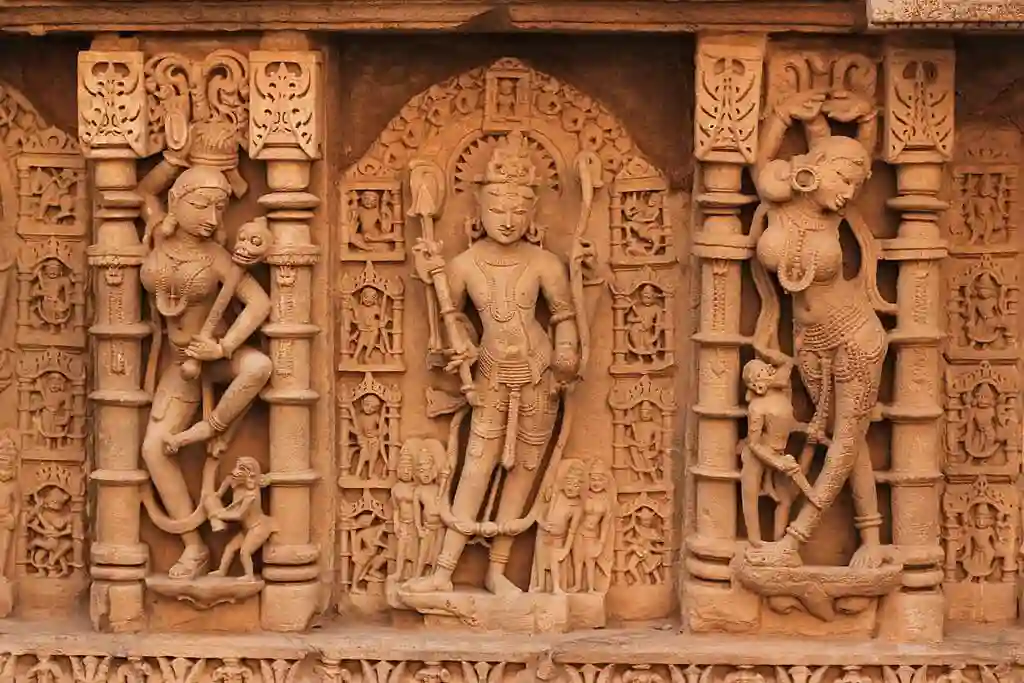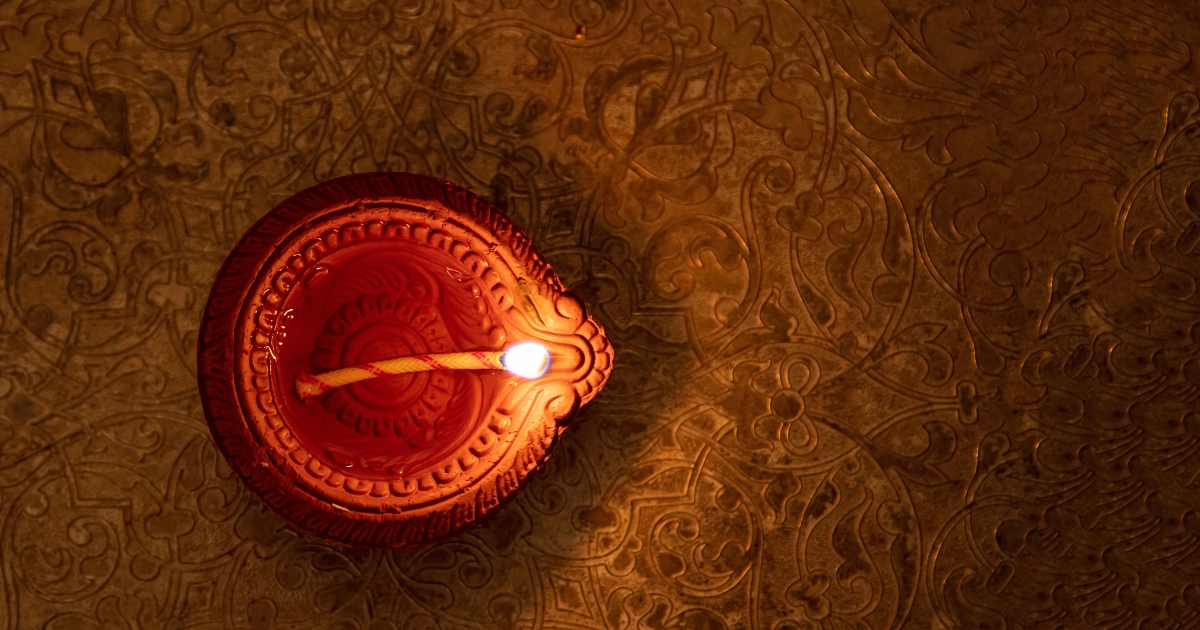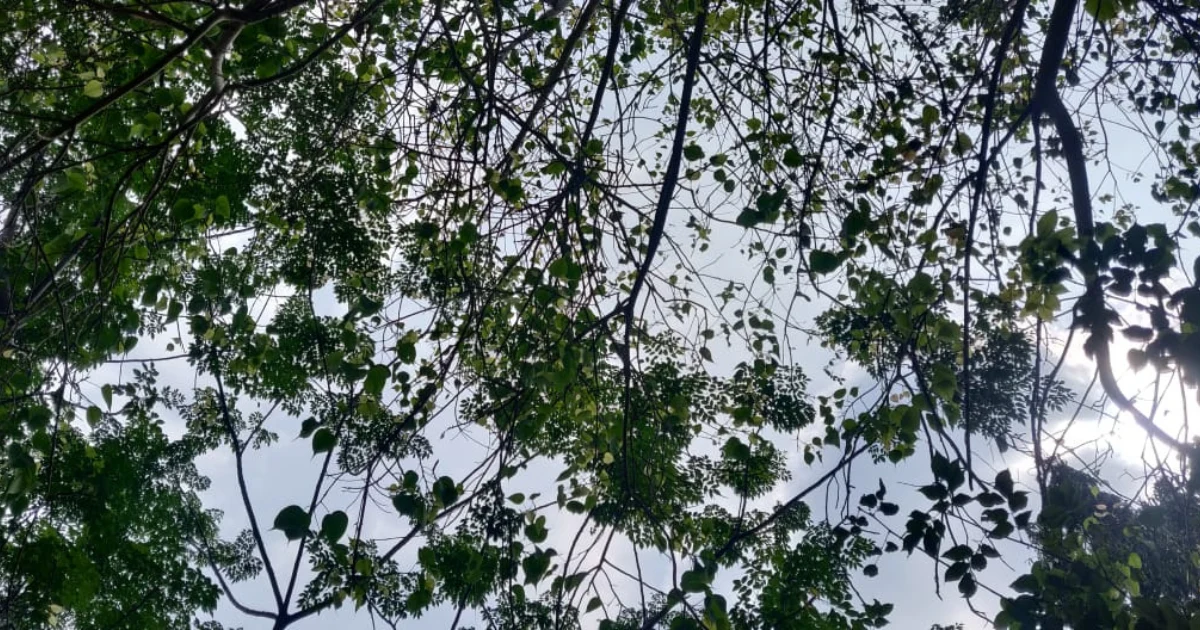“O your hair, he said,
It is like rain clouds
moving between branches of lightning.
It parts five ways
between gold ornaments
braided with a length of flowers
and the fragrant screwpine.”
From the Kalittokai, translation by AK RamanujanThe sight of me combing my long hair
brings you back to your country
where you tell me
girls sit in the open air
combing each other’s hair.
Poem for an Indian Scholar, from The Poems of Frances Chung“Adorned with golden koṉṟai1 flowers and garland
The new moon glittering on the long hair
Accompanied by radiant Mother Mēkalāmbikā2
My Lord will not leave Mēyaccūr3 temple.”
~ Saint Tirunāvukkaracar4
The vast treasure trove of scriptures and mural representations, spanning from the Vedic period to Vardhana dynasty, provide us with an invaluable window into the everyday lives of the people of ancient India. These captivating works of art and literature are not mere relics of the past; they are portals that unlock the secrets of a bygone era, revealing the intricate tapestry of cultural practices, beliefs, and even the art of hairstyling.
In ancient India, the art of hairstyling not just flourished, but it transcended the boundaries of mere fashion to become a reflection of individuality, a celebration of culture, and an everlasting mark upon the canvas of time. It was a testament to the belief that even in the most mundane aspects of life, one could find beauty, meaning, and the unbreakable spirit of the human soul.
Hairstyles held great importance in Vedic society, serving as markers of identity, social status, and even spiritual significance. The mention of hairstyles such as Opaśa, Kumba, Kaparda, Kurīra, Sīman, Pulasti, and Stuka suggests a rich variety of hairdressing practices prevalent during this period. In addition to the hairstyles themselves, the associated ornaments are also mentioned in the Vedic literature. Though the specific nature of these ornaments remains somewhat ambiguous, as the Vedic texts do not provide detailed descriptions. However, it is reasonable to assume that they might have encompassed various materials such as flowers, beads, precious metals, and gemstones.
The Harappans were quite interested in unique hairstyles and using combs and mirrors for making their hair-do. The presence of a mirror suggests a keen interest among Harappans for personal grooming and their desire to maintain well-styled hair.
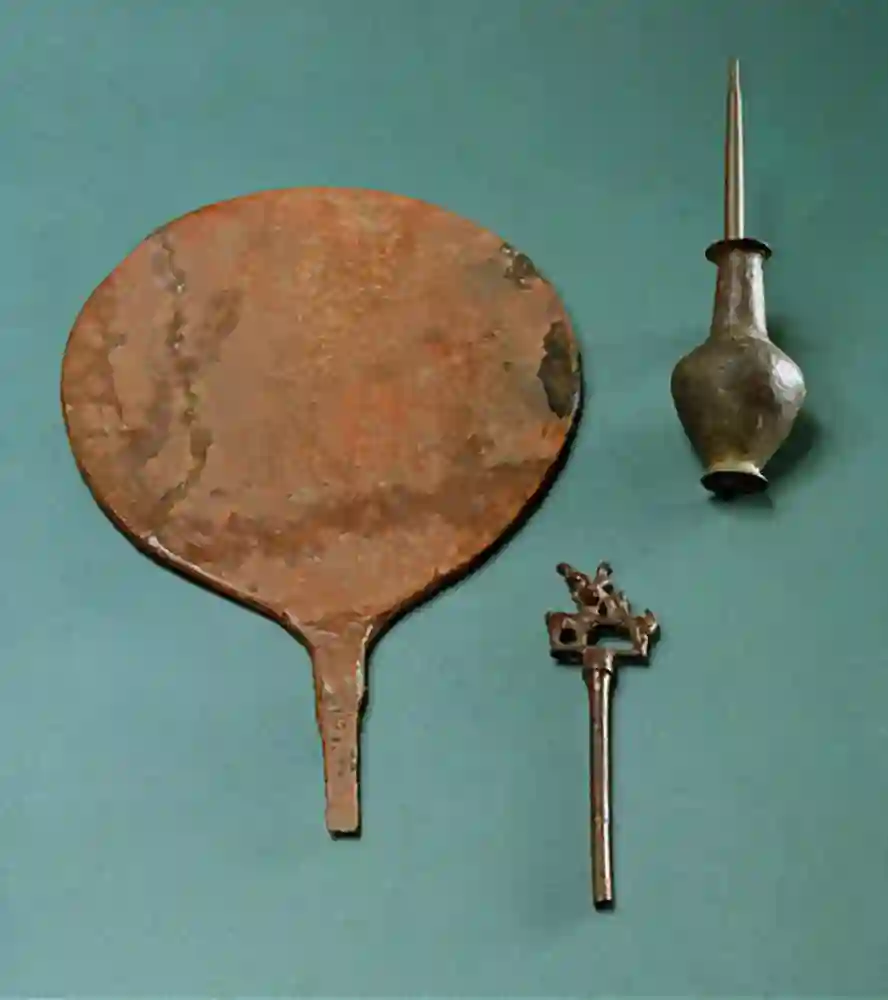
Another fine example of hairstyling in Harappan period is the famous Dancing Girl. Though her hairstyle is relatively simple, with her hair falling over the right shoulder in a thick mass, it reflects the significance given to hair presentation during that time. The meticulous attention to detail in depicting the hair indicates that hairstyles held cultural and aesthetic importance.
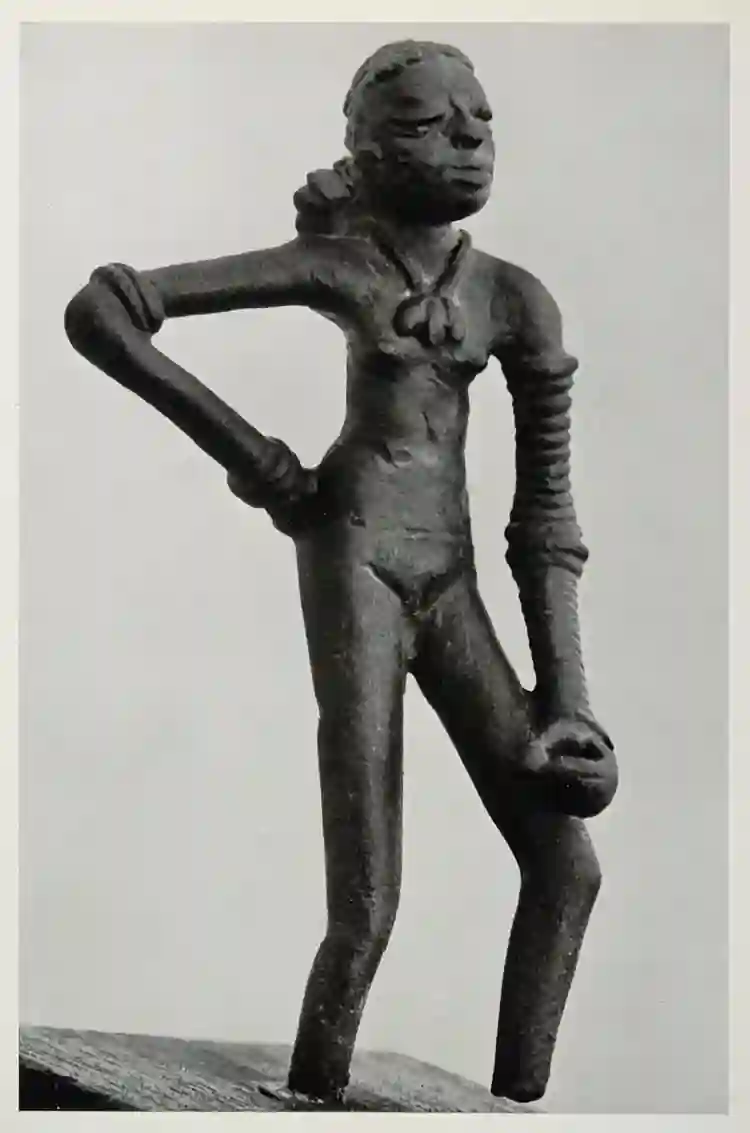
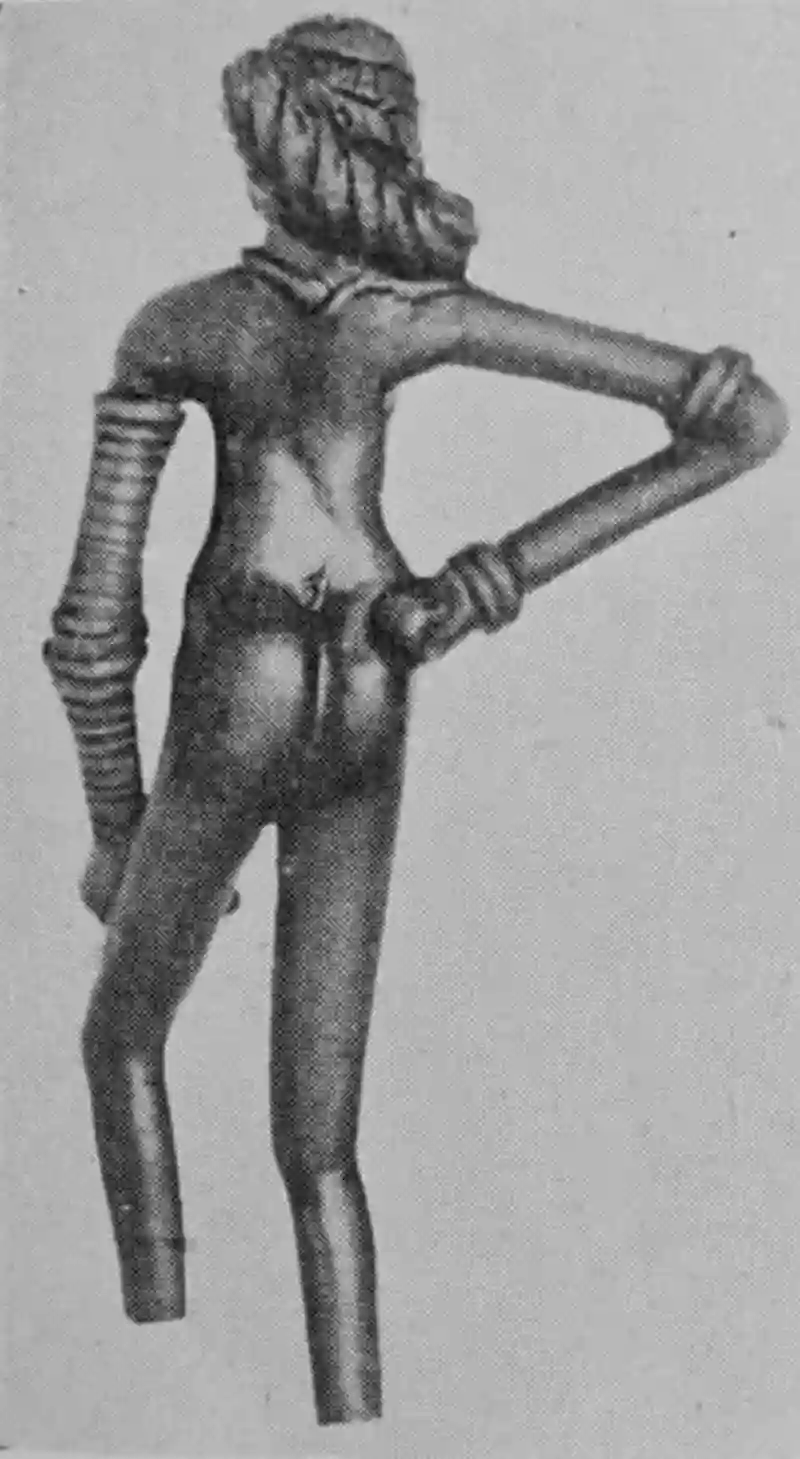
Additionally, the statue known as the Priest King discovered at the archaeological site of Mohenjo-daro provides us with intriguing insights into the hairstyle of an individual of high status during the Harappan period. The Priest King statue features a trimmed beard and hair parted in the middle. The hair is depicted as being tied with a fillet on the forehead, further emphasizing the individual's authority and status. The depiction of the Priest King's hairstyle aligns with the broader patterns observed in Harappan art, which often focussed on the precision and attention to detail in representing hair and other physical attributes.
Kauṭilya's Arthaśāstra, though a treatise on governance, sheds light on the two distinct styles of hairdressing that adorned the heads of women, captivating the imagination, and serving as markers of social identity. One glimpse into this world of intricate hair arrangements can be found in the graceful sculpture of Śālabhañjikā from Sāñcī. Her hair, an embodiment of elegance and artistry, is meticulously fashioned into a top fan-shaped bun, exuding an air of regality and sophistication. The careful arrangement of the front bun harmoniously contrasts with the flowing tresses cascading down her back, a harmonious interplay between structure and fluidity. This sculpture encapsulates the elaborate nature of hairstyling practices prevalent in ancient India, where every strand was crafted with meticulous care.
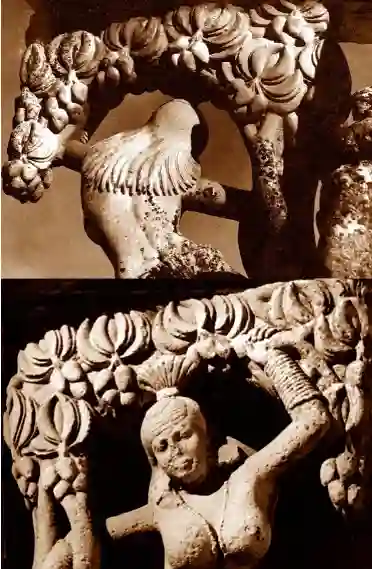
The women immortalized in the Bharhut sculptures present a captivating tableau of hairstyling diversity. These artistic renditions showcase a cornucopia of styles, each one a unique expression of personal taste and cultural affiliation. The panel depicting the worship of the Bodhi tree reveals women with neatly tied hair, securing it with a loose knot at the back. This understated yet refined hairstyle speaks of a harmonious blend of simplicity and grace, reflecting the nuances of femininity cherished in those bygone times.
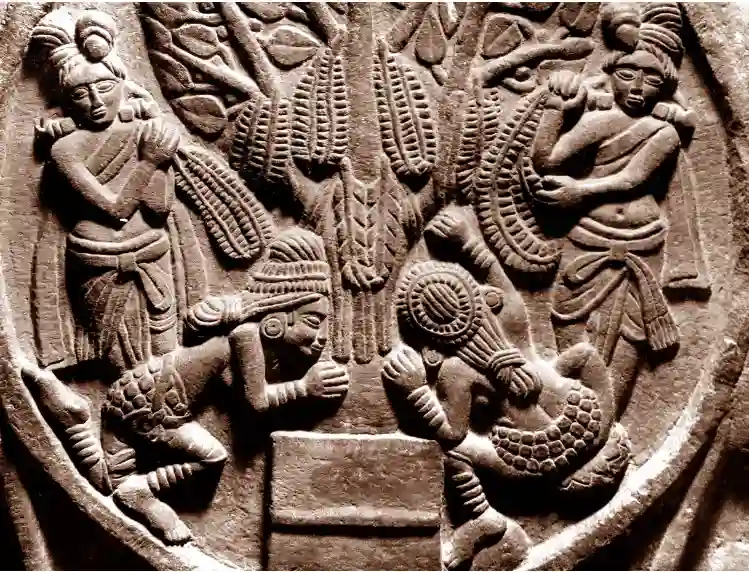
The magnificent Mauryan sculptures that are scattered across the diverse landscape of India, offer us a vivid imagery of the hairstyle and coiffures that adorned the heads of both men and women during the Mauryan period. These sculptures unveil a captivating array of masculine hairstyles, where each strand seems to embody an unwritten tale of grandeur. From flowing cascades of curls that delicately framed noble visages to neatly trimmed and coiffed hair, every choice of style conveyed a distinct message. These meticulously sculpted manes stood as symbols of authority, grace, and power, capturing the essence of a society where aesthetics merged seamlessly with societal roles.
Megasthenes and Arrian, in their accounts, paint a picture of an ancient Indian civilization where elaborate coiffures and hairstyles reigned supreme. From intricately braided and interwoven patterns to ornate adornments and accessories, every strand of hair seemed to tell a tale of artistry and individuality. Both men and women cherished their locks as canvases of self-expression, embracing a diverse range of styles that spanned the spectrum of societal roles and personal tastes.
Similarly, in the Sātavāhana period, we find such accounts in Hāla’s Gāthā Saptaśatī. Composed by King Hāla, this Sanskrit anthology of poems captures the cultural and social milieu of the time, offering insights into various aspects of life, including fashion and personal adornment. Within the verses of the Gāthā Saptaśatī, we find descriptions that shed light on the hairstyles known during the Sātavāhana period. These poetic accounts allow us to envision the diverse range of hair arrangements and coiffures that graced the heads of individuals during that era. While the specifics of the hairstyles mentioned in the Gāthā Saptaśatī may vary from poem to poem, they collectively reveal a vibrant array of styles that adorned both men and women. The verses depict various arrangements such as braids, buns, and intricate weavings, reflecting the artistic sensibilities and cultural preferences of the time.
Bharata Muni’s Nāṭyaśāstra, a seminal text on Indian performing arts and aesthetics, describes a variety of hairstyles that enables us to know the hairstyles of the Ikṣvāku period. Within the pages of the Nāṭyaśāstra, a rich tapestry of hairstyles unfolds, offering a glimpse into the artistic sensibilities and cultural practices of the Ikṣvāku period. The text goes beyond mere descriptions and delves into the significance of hairstyles in the realm of performing arts, where every aspect of presentation was carefully considered to enhance the portrayal of characters and evoke specific emotions.
The Divyāvadāna, and Vātsyāyana's Kamasutra collectively offer fascinating insights into the realm of ancient Indian hairstyles for both men and women. These texts, composed during different periods and with distinct purposes, contribute to our understanding of the diverse hairstyles that adorned individuals during ancient times. While the Divyāvadāna, a Buddhist scripture, contains accounts of various hairstyles prevalent in ancient India, Vātsyāyana's Kāmasūtra dedicates a section to the art of beautification, which encompasses various aspects such as hairstyles, makeup, and adornments.
Kālidāsa's literary sources, such as his plays and epic poems, often describe the beauty and elegance of women, including their hairstyles. One such example can be found in his famous play Abhijñānaśākuntalam (The Recognition of Sakuntala). In this play, Kālidāsa portrays the protagonist, Śakuntalā, as an epitome of feminine beauty. He lavishly describes her hair, emphasizing its captivating allure.
Kālidāsa frequently employs metaphors and similes to depict the hairstyles of women. For instance, in Raghuvaṃśa (The Dynasty of Raghu), he compares a woman's hair to a cascading waterfall, emphasizing its length and abundance. Such descriptions indicate that long, flowing hair was highly admired during the Gupta period. Furthermore, Kālidāsa's works often mention intricate hairstyling techniques employed by women. He alludes to the art of hairdressing, which involved intricate braiding, knotting, and ornamentation. Women would decorate their hair with various accessories like flowers, jewels, and ornamental pins, enhancing its beauty and adding a touch of sophistication.
The hairstyles of men during the Gupta period were also noteworthy. Although less extensively documented than women's hairstyles, Kālidāsa occasionally mentions men's hair in his works. In Kumārasambhava (The Birth of Kumara), he portrays the god Śiva with matted locks, symbolizing his ascetic and divine nature. Similarly, the Vāyu Purāṇa, the Amarakośa, the Viṣnudharmottara Purāṇa, Varāhamihira's Bṛhat Saṃhitā, and Harṣacarita by Bāṇabhaṭṭa often described hair as long, flowing, and meticulously adorned with ornaments.
Within the ancient scrolls of Viṣnudharmottara Purāṇa's Citrasūtra, a divine lexicon whispers of six enchanting hairstyles:
Kuntala, where tresses cascade freely like a babbling brook;
Dakṣiṇāvarta, where locks playfully coil towards the right, a whimsical dance of elegance;
Taraṅga, where waves of hair undulate like the gentle ocean's embrace;
Siṃhakeśara, a majestic crown reminiscent of a lion's untamed mane; Vārdhārā, a sacred parting that unveils hidden secrets;
And jaṭāṭasara, where strands intertwine and weave a tapestry of wild allure.
In conclusion, the artistry of hairdressing stood as a treasured tradition in ancient India, where the mastery of intricate braiding and knotting techniques reigned supreme. While the accounts of men's hairstyles were less lavishly detailed, occasional glimpses of matted locks hinted at their distinctive allure. These diverse hairstyles acted as mirrors, reflecting the cultural and aesthetic sensibilities that flourished during that era, while simultaneously serving as potent tools to enhance the beauty and enchantment of individuals. Such has been the captivating power of lustrous, dark tresses, that even the eminent poet Rabindranath Tagore couldn't resist their allure, immortalizing their charm within the verses of his poetic praise.
Ma tomai dekhey dekhey
Ankhi na firey
Tomar duar aji khuley gachchay
Sonar Mandirey
Tomar mukta kesher punja meghey
Lukai ashani,
Tomar anchal jholey akash taley
Roudra-basani“Mother we cannot take our eyes off your beautiful face
You have opened your door to all that is beautiful
In the dark clouds of your hair are hidden the weapons of destruction
Your ‘sāṛī is of the colour of golden sunlight
Mother, we cannot take our eyes off your beautiful face!”
Tagore, translated by Ila Palchoudhuri
Footnotes and References
(For Tamiḻ words, ISO15919 standard has been used to add diacritics in English transliteration, as opposed to IAST standard which is used elsewhere in the paper for English transliteration of Sanskrit words.)
- Hairstyles in Ancient Indian Art by K. Krishna Murthy
- Hair and Its Styling in Ancient India by J.P. Mittal
- The Indus Civilization: A Contemporary Perspective by Gregory L. Possehl
- Indian Costume: From 500 B.C. to the Present" by Kamaladevi Chattopadhyay
- Ancient Hair Styles of India by Ila Palchoudhuri
